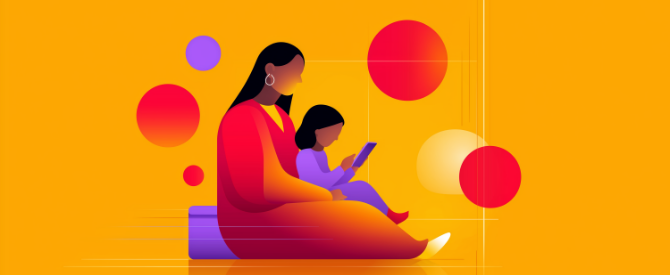
By Thabo Peyi
June 15th, 2025
7 min read
What Is an Incel, and Why Should We Be Talking About It?
Fresh off the back of a widely popular Netflix series – and at the centre of countless online debates and dinner-table conversations – the term ‘incel’ has taken the internet by storm. Yet, despite its growing presence in mainstream discourse, many people still don’t fully understand what an incel is, how incel ideology spreads online, and just how harmful it can be – particularly to impressionable children and teenagers, especially boys.

Related
Categories
All
Entertainment
Self Help
Tech News
Company Updates
Community
Social Media
What Is an Incel?
The term incel, short for “involuntarily celibate,” originally emerged as a term of support for people struggling with loneliness and romantic rejection. But with the rise of social media and controversial online personalities, it has morphed into a toxic online subculture. It now often serves as a platform for expressing misogynistic views, largely driven by frustration over the inability to find a romantic or sexual partner.
At its core, modern incel culture encourages a dangerous narrative: that women owe men attention, sex, or affection – and that rejection is a personal attack deserving of anger or retaliation.
The Real-World Impact of Incel Culture
While much of incel culture plays out online, its consequences are far from virtual. Those immersed in this ideology have, in some cases, gone on to commit acts of verbal and physical violence – driven by feelings of entitlement, humiliation, and powerlessness.
This is not just an internet trend. It’s a worldview that can influence behaviour in the real world – with serious consequences.

Who Is Most at Risk?
Incel ideology tends to attract teenage boys and young men, especially those between 16 and 29 years old, the most active age group on platforms like TikTok, Instagram, Reddit, and Twitter. This age group is in a crucial stage of emotional development, trying to understand themselves, their desires, and how to navigate romantic relationships.
These platforms often act as echo chambers, pushing extreme content to users based on previous interactions. As a result, a young person who watches one incel-style video can quickly find their feed flooded with similar (and more extreme) content. This is part of how social media algorithms promote incel beliefs and online misogyny.
Why Do People Become Incels?
Not everyone who faces rejection or feels lonely becomes an incel. So what pushes someone down this path?
Several factors may play a role:
- Repeated romantic rejection
- Lack of social support or friendship groups
- Poor mental health or undiagnosed conditions
- Rigid, outdated beliefs about gender roles and relationships
- Peer pressure from online or offline communities
When these elements combine in the wrong environment, it creates fertile ground for toxic masculinity and incel radicalisation to take root.

Types of Incel Content
Not all incel content looks the same. Some of it is subtle, wrapped in humour or disguised as self-help. Here are the main categories:
- Blackpill Content
This promotes the belief that men’s dating success is entirely based on looks, height, or wealth – denying the importance of personality or mutual connection, fuelling hopelessness. - Emotional Manipulation
Videos start with relatable emotions – loneliness, sadness – and twist them into blame towards women, deepening feelings of isolation. - Rage Content
Designed to provoke anger, this content attacks women outright, pushing anti-feminist narratives and spreading false ideas about male superiority. - “Humour” Content
Dark humour masks degrading jokes about women. Creators often dismiss criticism by claiming “it’s just a joke,” making harmful messages harder to challenge. - Influencer & Commentary Content
Viral podcasts or livestreams presenting “men vs women” debates often seek virality over genuine discussion. Figures like Andrew Tate, Sneako, and the Fresh & Fit podcast have become notorious for spreading incel ideology disguised as “male empowerment.”
Who’s Behind the Spread?
Two major culprits:
- Social Media Algorithms – Designed to keep users engaged, often by promoting more extreme content aligned with their past interactions.
- Toxic Influencers – Public figures who perpetuate harmful beliefs about women and masculinity, pushing toxic masculinity and incel culture under the guise of “truth-telling.”

How Can Parents Protect Their Children?
It’s not about banning the internet – it’s about building trust, communication, and critical thinking. Here’s how:
- Talk Often, Listen More
Ask what your child is watching online. Stay curious, not critical. Create a safe space for open conversations. - Teach Critical Thinking
Encourage questions like: Who made this? What’s the goal? Help them distinguish between helpful advice and harmful propaganda. - Validate Without Enabling
Acknowledge feelings like rejection or loneliness but avoid feeding into blame or resentment. - Spot the Red Flags
Watch for misogynistic language or jokes, obsession with appearance or social status, isolating from friends or family, and idolising toxic influencers. - Promote Healthy Outlets
Encourage friendships, hobbies, and real-world role models. Talk openly about emotions, respect, and healthy relationships. - Gently Monitor Media Use
Know what platforms they’re on and explain how algorithms shape beliefs. - Get Help Early
If worried, speak to therapists, school counsellors, or support services.
Incel culture is more than just an internet meme – it’s a growing and dangerous mindset that preys on vulnerability. But with awareness, open conversations, and strong support systems, we can protect young people and guide them towards healthier, more respectful views of themselves and others.
Latest Blogs
School holidays are coming! Learn how to manage your child’s…
Connecting South Africans to fast, affordable, and reliable fibre is…
What Is an Incel, and Why Should We Be Talking About It?

Thabo Peyi
June 15th, 2025
7 min read
Fresh off the back of a widely popular Netflix series – and at the centre of countless online debates and dinner-table conversations – the term ‘incel’ has taken the internet by storm. Yet, despite its growing presence in mainstream discourse, many people still don’t fully understand what an incel is, how incel ideology spreads online, and just how harmful it can be – particularly to impressionable children and teenagers, especially boys.

What Is an Incel?
The term incel, short for “involuntarily celibate,” originally emerged as a term of support for people struggling with loneliness and romantic rejection. But with the rise of social media and controversial online personalities, it has morphed into a toxic online subculture. It now often serves as a platform for expressing misogynistic views, largely driven by frustration over the inability to find a romantic or sexual partner.
At its core, modern incel culture encourages a dangerous narrative: that women owe men attention, sex, or affection – and that rejection is a personal attack deserving of anger or retaliation.
The Real-World Impact of Incel Culture
While much of incel culture plays out online, its consequences are far from virtual. Those immersed in this ideology have, in some cases, gone on to commit acts of verbal and physical violence – driven by feelings of entitlement, humiliation, and powerlessness.
This is not just an internet trend. It’s a worldview that can influence behaviour in the real world – with serious consequences.

Who Is Most at Risk?
Incel ideology tends to attract teenage boys and young men, especially those between 16 and 29 years old, the most active age group on platforms like TikTok, Instagram, Reddit, and Twitter. This age group is in a crucial stage of emotional development, trying to understand themselves, their desires, and how to navigate romantic relationships.
These platforms often act as echo chambers, pushing extreme content to users based on previous interactions. As a result, a young person who watches one incel-style video can quickly find their feed flooded with similar (and more extreme) content. This is part of how social media algorithms promote incel beliefs and online misogyny.
Why Do People Become Incels?
Not everyone who faces rejection or feels lonely becomes an incel. So what pushes someone down this path?
Several factors may play a role:
- Repeated romantic rejection
- Lack of social support or friendship groups
- Poor mental health or undiagnosed conditions
- Rigid, outdated beliefs about gender roles and relationships
- Peer pressure from online or offline communities
When these elements combine in the wrong environment, it creates fertile ground for toxic masculinity and incel radicalisation to take root.

Types of Incel Content
Not all incel content looks the same. Some of it is subtle, wrapped in humour or disguised as self-help. Here are the main categories:
- Blackpill Content
This promotes the belief that men’s dating success is entirely based on looks, height, or wealth – denying the importance of personality or mutual connection, fuelling hopelessness. - Emotional Manipulation
Videos start with relatable emotions – loneliness, sadness – and twist them into blame towards women, deepening feelings of isolation. - Rage Content
Designed to provoke anger, this content attacks women outright, pushing anti-feminist narratives and spreading false ideas about male superiority. - “Humour” Content
Dark humour masks degrading jokes about women. Creators often dismiss criticism by claiming “it’s just a joke,” making harmful messages harder to challenge. - Influencer & Commentary Content
Viral podcasts or livestreams presenting “men vs women” debates often seek virality over genuine discussion. Figures like Andrew Tate, Sneako, and the Fresh & Fit podcast have become notorious for spreading incel ideology disguised as “male empowerment.”
Who’s Behind the Spread?
Two major culprits:
- Social Media Algorithms – Designed to keep users engaged, often by promoting more extreme content aligned with their past interactions.
- Toxic Influencers – Public figures who perpetuate harmful beliefs about women and masculinity, pushing toxic masculinity and incel culture under the guise of “truth-telling.”

How Can Parents Protect Their Children?
It’s not about banning the internet – it’s about building trust, communication, and critical thinking. Here’s how:
- Talk Often, Listen More
Ask what your child is watching online. Stay curious, not critical. Create a safe space for open conversations. - Teach Critical Thinking
Encourage questions like: Who made this? What’s the goal? Help them distinguish between helpful advice and harmful propaganda. - Validate Without Enabling
Acknowledge feelings like rejection or loneliness but avoid feeding into blame or resentment. - Spot the Red Flags
Watch for misogynistic language or jokes, obsession with appearance or social status, isolating from friends or family, and idolising toxic influencers. - Promote Healthy Outlets
Encourage friendships, hobbies, and real-world role models. Talk openly about emotions, respect, and healthy relationships. - Gently Monitor Media Use
Know what platforms they’re on and explain how algorithms shape beliefs. - Get Help Early
If worried, speak to therapists, school counsellors, or support services.
Incel culture is more than just an internet meme – it’s a growing and dangerous mindset that preys on vulnerability. But with awareness, open conversations, and strong support systems, we can protect young people and guide them towards healthier, more respectful views of themselves and others.











